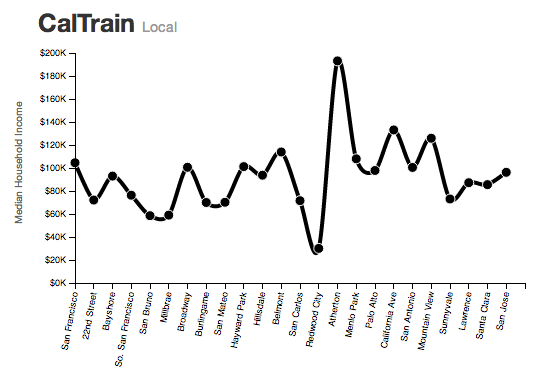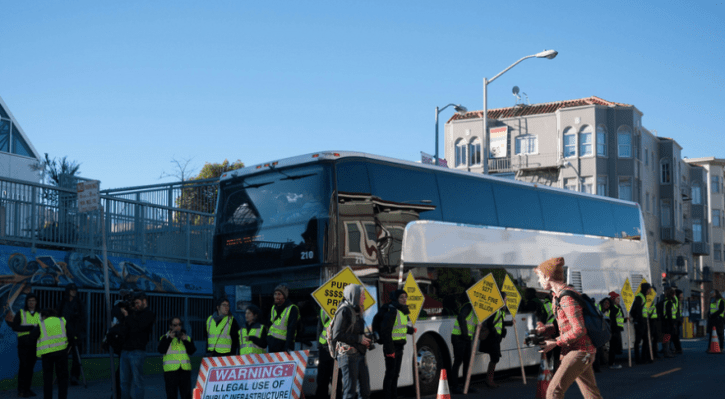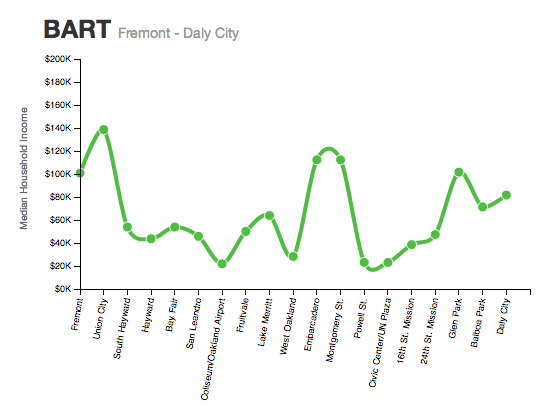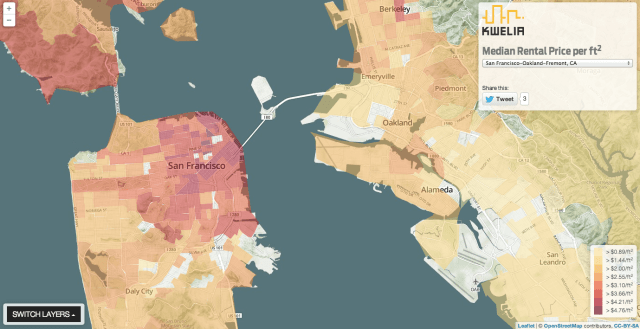There is a story being told about us here in the tech industry in San Francisco — that we are entitled, or that we are oblivious. I don’t believe that’s true. Or I don’t believe that it has to be true.
I’m worried that if we do not have a civil discussion soon, the situation will become violent or contentious beyond recognition. We have already seen rocks smash windows. Now, there are unidentified protesters stalking and harassing individual Google employees at their homes.
The bus protests during the last several months are a symptom of San Francisco’s perennial housing shortage, which has become especially pronounced with 75,000 people moving here over the last decade. Supply just hasn’t kept up with the city’s growth; San Francisco has added an average of 1,500 units every year for the last two decades.
This is a textbook supply-and-demand issue, which — Google buses or not — we can’t avoid. On top of that is another labyrinth of policy choices with unintended consequences like Proposition 13, rent control, the Ellis Act and an attitude of slow growth among those with influence over San Francisco’s permitting process. The bus protests are misguided, because taking buses off the road will increase traffic and it won’t reverse the tide of growth-stage companies that have decided to stay like Square, Twitter, Airbnb and Dropbox.
But they have done one good thing: they’ve pushed housing to the forefront of the mayor’s agenda. Last Friday, Mayor Ed Lee made a seven-point housing plan the centerpiece of his State of the City speech and announced plans to bring 30,000 new or rehabbed units online in the next six years. It’s not enough, but it’s a start.
This is not a new conflict. The Bay Area has two very strong historical legacies of social justice and technological solutionism. They seem more at war than ever, but this is a place where greed and idealism have always co-existed in a peculiar, and sometimes powerful, way. That potent combination created the Mac, which is celebrating its 30th birthday today, and put the world’s knowledge on smartphones in our pockets.
Recently, the tech industry has become a focal point of anger because there is such a jarring disconnect between the “Change The World” language of our industry and the very real and rising inequalities that sit in our own backyard.
Moreover, tech industry workers are increasingly treated like bankers during 2008 in the mainstream media. It’s strange considering how many people I know who came here because they wanted to work on hard, technical problems with meaningful impact.
I’m still researching what can be done, so this is a work in progress. Everyone is going to have to give a little.
Service As A Part of Company Culture
Somehow, somewhere, between my grandfather’s generation here in Silicon Valley and mine, our prevailing rhetoric changed from one of “service” to one of “changing the world.” There is a big gap between the two. The word “service” is deferential and empathetic to those around us, and “changing the world” is individualistic and full of hubris. We have to remember that with or without us, the world will change. That is its nature.
So we have to get back to a simple, humble place where we’re listening to the people that we share the city with. Maybe we’ll end up making more than “custom-designed, one-of-a-kind, bespoke” apps to communicate with our personal assistants.
Here’s an example: Zendesk, a San Francisco-based IPO candidate that was originally founded in Denmark, is running the “gold standard” of community benefit programs in the Tenderloin.
That’s according to Del Seymour, a former drug addict who now sits on the city’s Homeless Coordinating Board and gives tours to new Zendesk employees, so they can understand the history of the neighborhood they’re working in.
Seymour takes Zendesk employees to places like St. Anthony’s and the Gubbio Project, where hundreds of homeless people get to rest every day in the pews of the Tenderloin’s St. Boniface Church. He points out where he used to sleep in an old refrigerator bin during his six years on the streets, when he fell into drug abuse after working as a paramedic and firefighter for the city.
“I never thought I would end up there,” he told a crowd of Zendesk employees in front of St. Boniface’s doors.
The City Exposed: Touring the Tenderloin from San Francisco Chronicle on Vimeo.
Zendesk employees did about 1,400 hours of community service last year, doing everything from serving in soup kitchens to tutoring in the Tenderloin Tech Lab to hosting a tech camp for neighborhood kids. They are the only tech company receiving a payroll tax break from the city that won approval from the Citizens Advisory Committee for their community benefit program. The others, including Twitter, Yammer and One Kings Lane, all had their plans shot down this month. (All companies in the mid-Market area receiving the payroll tax break have to set up community benefit agreements.)
Community service has actually become a key recruiting tactic for the company, says the program’s creator Tiffany Apczynski, who spent four years as a journalist in the Tenderloin for the San Francisco Examiner before joining Zendesk.
“Other startups do all this stuff to build a culture. They bring in ping pong tables. They have happy hours,” she said. “But what we do to differentiate ourselves is our social responsibility. We want to avoid an Ivory Tower syndrome.”
Apczynski also knows that even as luxury apartment buildings sprout up on Market Street around Twitter’s headquarters, the Tenderloin won’t gentrify in a classic way. It can’t. Its single-room-occupancy residential hotels are protected by city laws and its historic non-profits like Glide and St. Anthony’s are politically powerful.
Other startups do all this stuff to build a culture. They bring in ping pong tables. They have happy hours. But what we do to differentiate ourselves is our social responsibility.
“Usually, gentrification swings all the way in one direction. But I feel like the Tenderloin is going to become a model for how to establish a truly mixed community,” she said. “San Francisco is a city of compassion. We take pride in our ability to accept everyone, no matter their condition.”
I want to be clear that I’m not promoting some kind of “white tech guy’s burden” or the notion that apps or college- or grad school-educated programmers can magically solve intractable problems like the drug abuse and mental illness that afflicts so many of our city’s chronically homeless.
But at the very least, this is just about empathy and understanding where others are coming from. This is about acknowledging that widening income inequality and media fragmentation have led us to a place where we can physically live on the same streets, and yet inhabit entirely different worlds.
While walking the Tenderloin with Seymour last week, I asked him what he thought people in San Francisco’s tech industry could do. He pointed at a group of teenagers on the street, who come in every day from the East Bay to sell dope at the corner of 6th and Market.
“Teach them how to code,” he said. “The only difference between them and someone in that nice building across the street is that they know how to code.”
The answers aren’t easy. They are time and resource-intensive, and they have to overcome so many of the inequities that are baked into the system to begin with.
But the possibilities are also cool. I mean, YCombinator-backed and San Francisco-based Crowdtilt runs a freaking crowdfunding platform and they just raised $23 million from Andreessen Horowitz last month. Their platform has raised funds for an Oakland mayoral campaign, a triple amputee injured by an improvised explosive device and sending the Jamaican bobsled team to the Sochi Winter Olympics. Imagine if local non-profits knew how to navigate it better.
Broader-Based Giving From Employees Across The Industry
We expect our CEOs and billionaires to give. There is a long, philanthropic tradition in the technology industry with organizations like the The William and Flora Hewlett Foundation and The Bill and Melinda Gates Foundation. Mark Zuckerberg and his wife Priscilla Chan also recently gave the largest single donation of last year with his nearly $1 billion gift to the Silicon Valley Community Foundation. Earlier this week, Zuckerberg gave $5 million toward construction of a new East Palo Alto medical clinic. Then Facebook co-founder and the world’s youngest billionaire Dustin Moskovitz has this lovely explanation about how he feels about his sudden wealth and responsibility.
But there isn’t really as strong a giving culture among rank-and-file employees.
I was inspired by what the 100 or so employees of Helsinki-based gaming startup Supercell did last December. In October, the company’s founders, investors and employees sold slightly over half of the company for $1.5 billion to Japanese mobile carrier Softbank and GungHo.
Around that time, the city’s local children’s hospital reached out to the company, because they hadn’t yet raised enough funding to replace their old, dilapidated location. The employees stepped up to collectively give about 3.4 million euros ($4.6 million) to cover a budget shortfall for constructing a new hospital. Participation was voluntary and the total amount raised was less than 1 percent of the proceeds from that deal.
Correct me if I’m wrong, but I don’t think I’ve ever seen employees of any tech company in San Francisco or Silicon Valley collectively donate a sum of that size. In fact, a friend of mine, who spent at least four years at Facebook, tried to rally his former co-workers to do something similar around the time the company IPO-ed. No such luck, which is an incredible shame.
The end of the Twitter IPO lock-up should come up in May. Imagine if any one of the company’s leaders like Dick Costolo or Jack Dorsey stepped up and encouraged current or former employees to support a worthy, local cause. Similarly, larger growth-stage companies like Square or Dropbox have had or are considering secondary rounds, where some employees will likely take cash off the table. If even 1 percent of this wealth was donated or committed to education, health or other local causes here, you’d have not only the raw money raised but you’d have a core of highly-educated, technically competent people invested in understanding these complex problems.
This is not really about the amount of money raised. This is about saying that San Francisco has given us a lot, and that we are all in it together.
Leadership From Google, Facebook, Apple and Twitter on Regional Housing
Here is an idea for a Google X moonshot: Bay Area housing.
It sounds ridiculous. But frankly, it’s a waste for Google to spend its time media coaching employees at a hearing for $1 fees on bus stops, when it could be joining forces with Facebook, Apple, Twitter and other large tech companies to push for regionwide housing solutions.
The tech shuttles exist because public solutions have failed us. Unlike New York City and its five boroughs, we don’t have a regional authority with sufficient power to coordinate development for the broader Bay Area. For decades, cities up and down the peninsula have resisted building the high density and walkable housing that young people want, so that burden is being placed upon San Francisco and Oakland.
We do not have a unified transit system surrounding the bay because San Mateo County decided in 1961 that it wanted to pull out of the BART project. Their political leadership didn’t want county taxpayer dollars paying for commuters shuttling between Santa Clara County and San Francisco. Instead, they wanted to spend their political capital on ensuring that Highway 280 would get finished. San Mateo’s decision prompted Marin to pull out too, so that’s why we have a patchwork transit system encircling the Bay.

Some maps of income inequality along Bay Area transit lines from San Francisco-based developer Dan Grover.
Then in San Francisco, even though there is overwhelming demand for housing, there are literally hundreds of neighborhood associations that have blocked construction for years. The homeowners and tenants’ rights organizations are tightly organized, but there is no one powerful speaking on behalf of prospective buyers or renters at city hall or planning commission meetings.
Take 1050 Valencia, which is supposed to turn an old KFC building in San Francisco’s Mission District into an apartment building. Its two sole affordable housing units were lopped off last month because the neighborhood association was concerned that the building’s proposed five-story height would affect the “character” of the street. Keep in mind that it’s taken 1050 Valencia six years to even get this far.
This is really, really important. When hyperlocal politics and NIMBYism are able to blockade regional development, it actually destroys most of the positive spillovers we would otherwise see from tech job creation into the broader economy. That’s because real wage gains are being held down by the high housing costs for everyone.
So controversial as it is to say, Google needs to start thinking about the entire Bay Area as a company town. They are one of the few entities here that has the capital and political clout to influence development across the entire region.
Remember that BART started out as a pipe dream after World War II in 1946 through many informal meetings between business leaders and mayors from around the Bay.
We need this kind of leadership again. Surely, if Apple, Facebook and Google can drop a few billion dollars and commission architects like Norman Foster and Frank Gehry to thoughtfully design their future headquarters, they can think intelligently about how to house all of the employees who will commute to work there. This may mean becoming more organized about confronting NIMBYists who are inadvertently denying others affordable housing in favor of preserving their own property values.
And lastly, for the protesters (if any activists actually read TechCrunch):
This is not going away. It’s painful to see friends and community members get displaced because of higher rents. But bus protests aren’t going to stop it.
These are the facts: there are six times as many people in California compared to when my grandfather grew up here. There are twice as many people in California compared to when my mother showed up in the Bay Area. Another 2 million people are expected to join us in the Bay Area over the next 25 years. Tech industry or not, people will get squeezed.
In 1968, Joan Didion wrote that, “California is a place in which a boom mentality and a sense of Chekhovian loss meet in uneasy suspension, in which the mind is troubled by some buried but ineradicable suspicion that things had better work here, because here, beneath that immense bleached sky, is where we run out of continent.”
Well, we ran out of space. The best idea Peter Thiel seems to have come up with is seasteading. Or Special Innovation Zones. Or VC Tim Draper’s idea of splitting California into six states.
We share this place. If the use of shuttle buses does get curtailed, Google’s loss is a Dropbox recruiter’s gain. You can bet that Twitter, which already has more than 2,000 employees, will double or triple its headcount with the roughly $2 billion it raised in November’s IPO.
So the vitriol doesn’t help. If anything, it’s emblematic of what is so antagonistic, selfish and myopic about American politics.
There is a reason why a libertarian vein runs through the technology community here. It’s not borne out of callousness or indifference. It comes from a pervasive feeling that our institutions have become too sclerotic and encumbered by special interests to serve us. There is distrust on both sides. It doesn’t have to be this way.
A lot of people in the tech industry are well-educated and driven. They considered politics or entertainment or medicine as careers and decided that the mix of technology and entrepreneurship was the fastest way to build and deploy something that hundreds of thousands or millions of people would use and love.
This is why even the most powerful tech companies avoid dealing with government until the very last minute, when they absolutely have to do it. When the tech industry engages in realpolitik to achieve an end goal like immigration reform, it’s incredibly divisive within the community.
That’s because we are not a monoculture. The reason the tech industry has grown so powerful over the last decade is because it is seeping into every area of our lives. Software is eating the world, as Marc Andreessen says.
So we are not just tech. We are tech-meets-education, tech-meets-healthcare, tech-meets-civil engineering, tech-meets-organic-food, tech-meets-interior-design, tech-meets-agriculture, tech-meets-law, tech-meets-healthcare-in-the-developing-world, tech-meets-microfinance, tech-meets-AIDS-research and so on. We have the less savory worlds of ad tech and social casino gaming, and then we have robots that will perform tele-surgeries and people working on brain-computer-interfaces and hacking the human genome.
We are also aware we need a heterogeneity of perspectives. How else are we going to work on primary school education? Or homelessness? Or unemployment? Or patronage for the arts? A world where we’re all building photo-sharing apps would be really boring.
I personally take great care in making sure that my friends in San Francisco include nurses, teachers and hospice care workers too. No one is happy when the elderly like the Lees or Mission muralists René Yañez and Yolanda Lopez are thrown out of their homes in their sickness and old age. And, as someone who comes from a family that has been in the industry for 60 years, I am equally horrified when grubby newcomers like Greg Gopman and Peter Shih show up and say appallingly uninformed things.
Yet San Francisco is changing, as it has and as it always will.
The activism of my generation of idealistic capitalists isn’t as visceral as the kind that rocked San Francisco in the 1960s with the anti-war protests or the 1980s during the AIDS epidemic. It comes in bits and bytes and is guided by profit and loss.
“I don’t have the money to lobby Congress, but I do have the power to build technology that can help the community contribute resources,” said Rose Broome, who started HandUp, a platform for donors to directly support individual homeless people with food, clothing, shoes and dental care. “I feel an urgency. Our existing safety nets are not sufficient.”
She started HandUp because every time she walked the streets of San Francisco and saw someone huddled and sleeping on the sidewalk, she felt this urge to give. But she didn’t know their circumstances.
If you want to see something beautiful, watch these videos of Rodney Bell. He’s a 42-year-old paraplegic dancer who became homeless in the Tenderloin last fall when he got laid off from an Oakland dance company. Through 28 donors on Broome’s HandUp platform and with help from San Francisco’s Project Homeless Connect, he was able to raise enough money to rent a place and buy a laptop to look for a new job.
So we’re a little more Chillwave than Grateful Dead. Our art may come in the form of a Burning Man art car, data visualizations or a Robot Dance Party instead of the beautiful and historic murals that adorn the Mission.
Critics lament that if tech culture is allowed to pervade the city, San Francisco will stop making contributions to the world like it did with the creation of the Sierra Club. But in the last few years alone, the city has given the world a new way of consuming and spreading news and produced the world’s leading companies in the collaborative consumption movement, which is creating community in farflung parts of the world and making the use of resources like physical space and cars more efficient.
While writing this essay this week, I ran into one of the Supercell shareholders in a coffee shop. He lives in Silicon Valley, but gave money toward construction of the children’s hospital in Helsinki.
I asked him, why would you donate to a hospital in a faraway city that you’ve never lived in?
“Because I felt a sense of community,” he replied.
Maybe if we stopped screaming at each other, it would feel like that here too.


